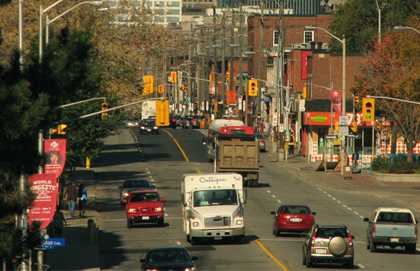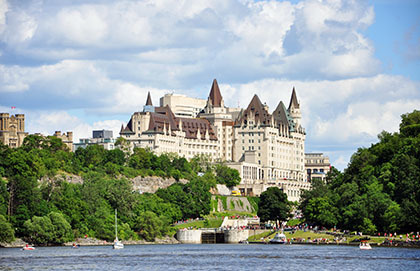This is part three of Convivium’s series on Northern Ireland and its history as it exists today. Click here to read part two: "Ireland's Accidental History."
Belfast, Northern Ireland – It’s intriguing to watch across an ocean as turbulence continues to cycle in Ottawa over the state and fate of the national capital’s Château Laurier Hotel.
Even from the distance of Northern Ireland, it’s evident that local uproar over a pug ugly addition planned for the city’s pride-of-place hotel is entirely right and justified. My Convivium colleague Father Raymond de Souza, knocking it out of the park as usual, recently summarized the upset by suggesting that once the expansion is completed, a name change to Château Shipping Container would be appropriate.
As Father de Souza and others have argued, the permit process that began in 2016 is an instant case study in political furry creatures scurrying to avoid responsibility. It culminated July 11 when Ottawa council defeated attempts to have the owner at least soften the sharper edges of architectural abomination.
Mayor Jim Watson guaranteed his induction into my personal WTF Hall of Fame with his explanation that the Château, a designated National Historic site for almost 40 years, is the private property of Vancouver-based Larco Investments Ltd. and therefore beyond the city’s reach in terms of curbing any street-facing hideousness. Ottawa residents with an urge to assemble abattoirs on their front lawns might keep Mayor Watson’s elementary approach to property rights in mind.
Beyond the justice of the (albeit belated) protest against the expansion plan, though, it’s fascinating from this side of the Atlantic to track the way buildings such as the Château provoke civic backlash when attempts arise to alter them.
It can clarify their power to create and reinforce of our understandings of ourselves. It arguably shows, in certain circumstances, how they can undergird politics far greater than the sum of the street corners on which they stand.
An example came home to me here in Belfast as I stood gawping at the city’s massive city hall that, to adapt a phrase from the poetic curmudgeon Philip Larkin, squats like an overgrown confectioner’s toad in central Donegal Square. In size, scope and sheer visual gussyness, it seems the kind of imperial monstrosity that only the late Victorian mind hallucinating limitless industrial expansion and progress could produce.
It opened its doors in 1906. That was five years after the aptly dubbed Famine Queen went off to whatever eternal judgment awaited the monarch of a million Irish deaths in the Great Hunger of 1845 to 1850.
“Victoria… must tremble as death approaches when she thinks of the countless Irish mothers who, sheltering under the cloudy Irish sky, watching their starving little ones, have cursed her before they died,” Maude Gonne wonderfully wrote.
But I digress.
Victoria had, however, granted Belfast the status of city in 1888. Her majestic generosity provided impetus to start construction of the city hall in 1898 while the Famine Queen was, unlike those million lost Irish souls, still alive and kicking colonials around.
The period was an economic apogee for the metropolis as its linen industry, rope making factories, engineering sector and, above all, ship building hit the top of their arcs. It surpassed Dublin as Ireland’s leading city and, indeed, was one of the British Empire’s great “success” stories (see cloudy Irish skies above). More, though, the building of the city hall was the capstone not only in the expansion and growth of the city but in its re-creation and ultimately, re-imagination.
In the mid-19th century, the Presbyterian clergyman Henry Cooke declared that Belfast only came into existence in about 1840, even though an elegant Georgian city had grown in place since the early 1700s. The mindset expressed by Cooke effectively became a self-fulfilling prophecy, and the buildings of the Victorian era were incontrovertible evidence of its (at least imagined) truth. The past was essentially torn down and a new past, one powered by the doctrine of the inevitability of progress, was conceived of and materially constructed in its place. The most “barbarous nook in Ireland” (John Milton’s description) became a “funnel of prosperity” that channeled wealth and power through all those new Victorian edifices.
And then the Titanic sank. Belfast’s engineering marvel went down 11 years and two months after the demise of Victoria and the end of Victoriana.
In one of those coincidences that make even history shake its gray head, the Titanic sinking was such a monumental event that it even delayed by six weeks the opening of the Château Laurier in a former lumber town called Ottawa. The president of the Great Northern Railway, Charles Melville Hays, was to preside over a grand opening of the company’s new showcase hotel on April 26, 1912. He was among 1500 or so who died in the Titanic sinking on April 15. The Château quietly opened in June.
But the black clouds gathering around Belfast city hall, where a monument to the Titanic victims was erected, went beyond even that horrible death toll. In 1912, the British parliament finally approved Home Rule for Ireland, giving the island back at least a measure of the political liberty criminally wrenched from it in the1800-1801 Act of Union. In September that year, tens of thousands of so-called unionists, implacably opposed to Home Rule, signed a “Solemn League and Covenant” issued at Belfast City Hall pledging to use “all means which may be found necessary” to oppose legislated freedom for Ireland.
They warned of their refusal to accept the authority of the law. Some reportedly signed in blood. Less than a year later, local militias were organized into the Ulster Volunteer Force. Arms were smuggled in at Larne, just outside of Belfast. War was being prepared, if not openly declared.
Explanations exist for the unionist reaction. Protestant fear of being overwhelmed by the vast Catholic majority is one of them. Legislative, and therefore authoritative, power would inevitably tilt south again to Dublin despite years of economic and political gains that had made Belfast the de facto capital of Ireland’s northern region. Anti-Catholic bigotry is another explanation: “Home Rule is Rome Rule” was a popular slogan at the time. So is a genuine belief that life sheltered within the indefatigable British imperium was both the moral and pragmatic best choice.
But walking through the Victorian reminiscences of Belfast’s city centre, particularly standing gawping at its toad’s confection city hall, an additional possibility suggested itself.
It was much more rooted in the street than floating detached in the creedal or ideological breeze. It was the buildings themselves. Having sunk their identities, their hopes, their understandings of the past and projections of the future, into mythologies of stone and wood and particular shaped turrets and porches and exterior surfaces, how could they possibly just let everything go?
Faced with abstract political change, at least one elementary particle of the response appeared to require turning to the self-evident localism of the city itself. We have a tendency to think social re-ordering emerges from State policy, from ideational theorizing, from things written down and speechified. But Belfast City Hall makes evident how the built environment itself was not only the work of local hands, but also brought a people into being as they imagined and re-shaped themselves.
We build our buildings. They then build in us the vocabulary of who we come to believe we are. From the distance afforded by an ocean at least, the same forces can be perceived at work in the (expressly non-violent) civil call to arms over the disruption of the Château Laurier. No one, of course, is issuing solemn convents signed in blood or fantasizing militias to deal with the renovation, however pug ugly, of a downtown Ottawa hotel. Thanks be to God for that. But the vehemence of the defensive reaction contains an instructive irenic echo.
The Château, pardon my opinion, is, all said, a pretty flawed iconic hotel as iconic hotels go. Like Belfast City Hall, it too squats in hyper-inflated toadal gloat at the end of Wellington Street. An earlier bungled extension transformed its mirroring of the Parliament buildings into a bloated parody of small-town rube’s Disneyfied notion of Prince Valiant’s castle. Whenever I look up at it from the Rideau Canal, I reflexively wait for Peter Pan and Tinker Bell to fly past dragging a pre-gay-pride rainbow over its ersatz Gothic Revival roof.
Inside makes outside look pretty darn near close to something like fake authentic. A wise man I know says the best thing about the Château is its lobby. All you have to do, he says, is sit there all day and soon or later everyone you want to meet will come through.
That’s a recommendation, all right, as long as you don’t have to pay the eye-tearing price gouging meals in the Laurier Room or stay in one of the many guest rooms that are so small no self-respecting flea would go through the contortions necessary to get suitcase and self through the door at the same time.
Even the luxury suites are laughable but for the exact opposite reason: they are simply outsized ludicrous. I once attended an event in the Queen Somebody or Other Suite and it was a hysterical concatenation of visual non sequiturs all apparently aimed at making everything feel real high class. After a while, I hung out by the nibblies waiting for panjandrums in pyjamas to come through on a herd of elephants.
But that’s all right. As the mayor of Ottawa himself mused aloud, it’s private property. Whoever owns it can decorate to their own taste, charge what the market will bear and if they so wish, maybe once in a while serve food that a polecat’s mother would walk past.
What remains unjust is arbitrary architectural trifling with the mythologies that people in Ottawa, and even to an extent the hotel’s recurrent guests, have created and, in turn, been created by. Whatever faults it might have, the Château is not only an Ottawa hotel. It is Ottawa’s iconic high-end luxury hotel, meaning Ottawa has an iconic high-end luxury hotel, meaning Ottawa deserves an iconic high-end luxury hotel.
The nation’s capital is not just some rinky-dink polecat lumber town turned civil service economy any more, no, and hasn’t been for a good long time – ever since the Titanic sank and the Château Laurier opened if you want to know the real facts. Meaning – and this is what really matters – it has a noble history that points to a glorious future.
As long as the building we built is there to tell us that past and assure that future, we’ll have the means to believe it’s true. Best not to mess with it in order to avoid further turbulence.
This is part three of Convivium’s series on Northern Ireland and its history as it exists today. Click here to read part four: "Belfast, Brexit and Boris Johnson."






